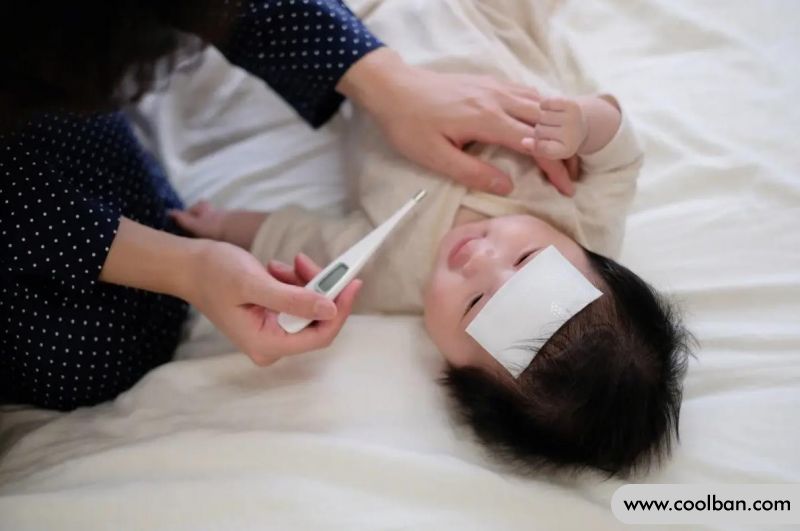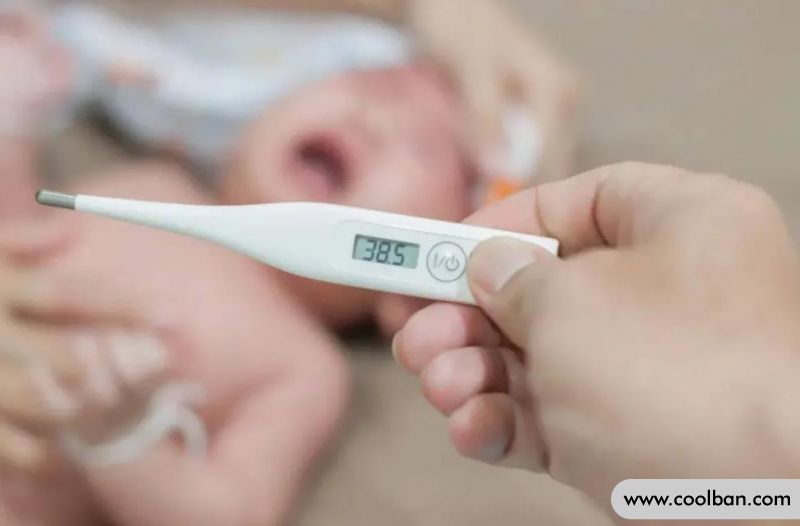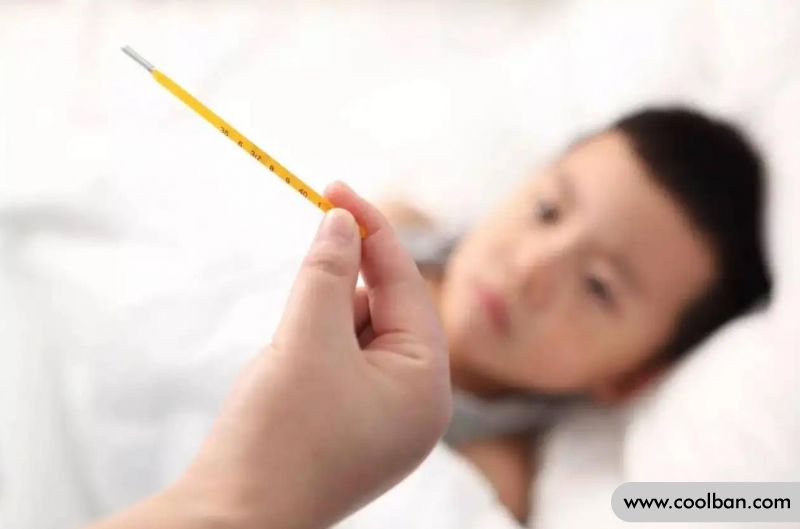Cooling method for baby's high fever
2022-04-28
Hyperthermia in babies is a very common symptom of babies whose body temperature exceeds the upper limit of the normal range for babies. Today, I will take you to learn about some treatment methods for high fever in babies.

Causes of high fever in babies
From childhood to adulthood, there are more or less symptoms of fever. Some parents will be anxious and seek medical treatment everywhere, while some parents just want the child to quickly reduce the fever, and the food and stuff will come. To the surprise of parents, the baby's high fever still did not subside after taking the medicine. What's going on?
The baby's body temperature does not drop after taking antipyretics for high fever, which may be related to the following aspects:
Reason 1: Insufficient dose of antipyretic
Reason 2: Insufficient water in the body, that is, insufficient intake
Reason 3: The child is not sensitive to this antipyretic
Reason 4: Parental expectations are not reached
Antipyretics can only temporarily reduce the fever, not stop it. Virus and bacterial infection, the baby's high fever usually lasts for several days. The temperature may also rise several hours after taking antipyretics, and once the infection is under control, the temperature will not rise again.

Physical cooling of baby's high fever
Is there any way to cool down quickly when you have a fever? Try these cooling methods.
Physical cooling method
Method 1: Wear less and cover less
Wear less clothes and cover less quilt to let your baby cool off naturally.
Method 2: Antipyretic paste
Generally suitable for preschool children. When the baby has a fever, you can stick one on the forehead or the part where the large blood vessels run to reduce the body temperature through the physical changes of water vaporization and heat absorption.
Method 3: Warm water bath
Warm water baths are suitable for babies with high fever to cool down. The method is to use a hot water bath that is slightly higher than the baby's body temperature, and wipe the baby's whole body skin more. For parts with rich blood vessels such as the neck, armpits, elbows, groin, and popliteal fossa, the wiping time can be slightly longer to help dissipate heat.
Method 4: Warm and moist compress
This method achieves the purpose of cooling and reducing fever by dilating blood vessels, exposing the skin, evaporating epidermal water, and increasing the chance of heat dissipation of the skin on the surface of the body. The specific method is to wipe the whole body with a warm water towel, soak the towel in warm water for a while, control the water temperature between 32 ℃ ~ 34 ℃, then take out the towel, twist it until it is half dry, and wipe the baby's whole body, especially the places with many wrinkles, such as Neck, armpits.
Method 5: Soak feet
Control the water temperature so as not to scald the baby, soak for more than 15-20 minutes, let the baby sweat and cool down.

Treatment The method of baby's high fever
When your baby has a high fever, use the following fever reduction methods to help your child feel more comfortable:
Method 1: Reduce clothing. When you have a fever, remember not to put too many clothes on your child and cover them with too thick quilts. This traditional method of "covering sweat" is not conducive to heat dissipation and fever reduction, but will lead to febrile convulsions due to overheating. For many babies, reducing the amount of clothing can lower their body temperature.
Method 2: Drink more water. It helps to perspire and dissipate heat. In addition, water has the effect of regulating temperature, which can lower body temperature and replenish water lost by the body.
Method 3: cold compress method. This method is simple and easy to use, apply a cold towel to the forehead, soak the towel in cold water after it becomes hot, and apply it again. For older children, cold packs or ice packs are better.
Method 4: Take a bath or bath with warm water all over the body. Undo the child's clothes, wipe the whole body with a towel with warm water (about 37°C) or take a bath, which can expand the blood vessels of the skin and increase the heat dissipation. In addition, when the water evaporates from the body surface, it will also lose some heat.
Method 5: Rub the bath with warm alcohol. Alcohol rubbing bath Mix 70% alcohol with 1/1 tap water, the diluted water temperature is about 37℃-40℃, put it in a small bowl. When wiping the bath, close the doors and windows, use gauze or a soft towel dipped in the alcohol in the bowl, and wipe the child's palms, soles, armpits, inner upper arms, and the base of the thighs, then the limbs and back. Do not wipe directly with alcohol, this method is not suitable for babies under 1 year old.

The harm of high fever in babies
If the fever is serious, it is not serious. If it is not serious, it is actually very serious. It mainly depends on the degree of the fever and what kind of people have the fever. For example, a high fever can be very dangerous for a child. What are the dangers of a fever to a baby?
Hazard 1: Babies with high fever may have high fever spasms. Generally speaking, once fever occurs, there will be one or two high fever spasms. If high fever spasms occur repeatedly, it will lead to brain hypoxia and cause damage to the brain.
Hazard 2: If the baby's fever exceeds 41°C, it is likely to cause cerebral edema, sequelae such as epilepsy, and even death.
Hazard 3: During the process of fever, sweating and heat dissipation, the lack of water in the body not only affects heat dissipation, but also may affect blood circulation and body metabolism, resulting in acidosis.
Hazard 4: Fever in malnourished infants may also cause hypernatremia or hyponatremia.
Fever should be treated in time. If you don't want to see a doctor and don't want to take medicine, you can try physical therapy, but you can't delay it, especially for children with weakened immune systems. You must know that the baby's high fever will not only leave sequelae, but may also be life-threatening. Therefore, do not ignore the baby's high fever.

Causes of high fever in babies
From childhood to adulthood, there are more or less symptoms of fever. Some parents will be anxious and seek medical treatment everywhere, while some parents just want the child to quickly reduce the fever, and the food and stuff will come. To the surprise of parents, the baby's high fever still did not subside after taking the medicine. What's going on?
The baby's body temperature does not drop after taking antipyretics for high fever, which may be related to the following aspects:
Reason 1: Insufficient dose of antipyretic
Reason 2: Insufficient water in the body, that is, insufficient intake
Reason 3: The child is not sensitive to this antipyretic
Reason 4: Parental expectations are not reached
Antipyretics can only temporarily reduce the fever, not stop it. Virus and bacterial infection, the baby's high fever usually lasts for several days. The temperature may also rise several hours after taking antipyretics, and once the infection is under control, the temperature will not rise again.

Physical cooling of baby's high fever
Is there any way to cool down quickly when you have a fever? Try these cooling methods.
Physical cooling method
Method 1: Wear less and cover less
Wear less clothes and cover less quilt to let your baby cool off naturally.
Method 2: Antipyretic paste
Generally suitable for preschool children. When the baby has a fever, you can stick one on the forehead or the part where the large blood vessels run to reduce the body temperature through the physical changes of water vaporization and heat absorption.
Method 3: Warm water bath
Warm water baths are suitable for babies with high fever to cool down. The method is to use a hot water bath that is slightly higher than the baby's body temperature, and wipe the baby's whole body skin more. For parts with rich blood vessels such as the neck, armpits, elbows, groin, and popliteal fossa, the wiping time can be slightly longer to help dissipate heat.
Method 4: Warm and moist compress
This method achieves the purpose of cooling and reducing fever by dilating blood vessels, exposing the skin, evaporating epidermal water, and increasing the chance of heat dissipation of the skin on the surface of the body. The specific method is to wipe the whole body with a warm water towel, soak the towel in warm water for a while, control the water temperature between 32 ℃ ~ 34 ℃, then take out the towel, twist it until it is half dry, and wipe the baby's whole body, especially the places with many wrinkles, such as Neck, armpits.
Method 5: Soak feet
Control the water temperature so as not to scald the baby, soak for more than 15-20 minutes, let the baby sweat and cool down.

Treatment The method of baby's high fever
When your baby has a high fever, use the following fever reduction methods to help your child feel more comfortable:
Method 1: Reduce clothing. When you have a fever, remember not to put too many clothes on your child and cover them with too thick quilts. This traditional method of "covering sweat" is not conducive to heat dissipation and fever reduction, but will lead to febrile convulsions due to overheating. For many babies, reducing the amount of clothing can lower their body temperature.
Method 2: Drink more water. It helps to perspire and dissipate heat. In addition, water has the effect of regulating temperature, which can lower body temperature and replenish water lost by the body.
Method 3: cold compress method. This method is simple and easy to use, apply a cold towel to the forehead, soak the towel in cold water after it becomes hot, and apply it again. For older children, cold packs or ice packs are better.
Method 4: Take a bath or bath with warm water all over the body. Undo the child's clothes, wipe the whole body with a towel with warm water (about 37°C) or take a bath, which can expand the blood vessels of the skin and increase the heat dissipation. In addition, when the water evaporates from the body surface, it will also lose some heat.
Method 5: Rub the bath with warm alcohol. Alcohol rubbing bath Mix 70% alcohol with 1/1 tap water, the diluted water temperature is about 37℃-40℃, put it in a small bowl. When wiping the bath, close the doors and windows, use gauze or a soft towel dipped in the alcohol in the bowl, and wipe the child's palms, soles, armpits, inner upper arms, and the base of the thighs, then the limbs and back. Do not wipe directly with alcohol, this method is not suitable for babies under 1 year old.

The harm of high fever in babies
If the fever is serious, it is not serious. If it is not serious, it is actually very serious. It mainly depends on the degree of the fever and what kind of people have the fever. For example, a high fever can be very dangerous for a child. What are the dangers of a fever to a baby?
Hazard 1: Babies with high fever may have high fever spasms. Generally speaking, once fever occurs, there will be one or two high fever spasms. If high fever spasms occur repeatedly, it will lead to brain hypoxia and cause damage to the brain.
Hazard 2: If the baby's fever exceeds 41°C, it is likely to cause cerebral edema, sequelae such as epilepsy, and even death.
Hazard 3: During the process of fever, sweating and heat dissipation, the lack of water in the body not only affects heat dissipation, but also may affect blood circulation and body metabolism, resulting in acidosis.
Hazard 4: Fever in malnourished infants may also cause hypernatremia or hyponatremia.
Fever should be treated in time. If you don't want to see a doctor and don't want to take medicine, you can try physical therapy, but you can't delay it, especially for children with weakened immune systems. You must know that the baby's high fever will not only leave sequelae, but may also be life-threatening. Therefore, do not ignore the baby's high fever.
